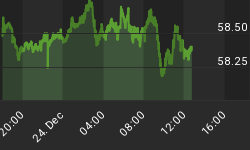The 17% decline in oil prices so far this year has recalibrated the FX equation in so far as bolstering expectations of a US consumer-led stability to act as a stabilizer to housing's downside risks. This has considerably diminished chances of a March Fed cut and manifested itself across European and Asian currencies. The role of oil's rebound has been such that it took center stage in FX markets, shadowing a string of positive economic data from the Eurozone and the UK. Aside from freeing US consumers' wallets, falling oil prices have reduced the Sep-Nov trade deficit by over 17%, which is likely to contribute as much as 0.7% to Q4 GDP.
Now that record high winter temperatures may be behind of us, we can expect prices to remain stable as long as the OPEC members of the Arabian Gulf succeed in blocking additional supply cuts, beyond the already implemented 1.2 million barrels per day and 500K bpd scheduled for next month. The most likely outcome is for OPEC to assess where prices would reach by February 1st and examine the market impact of the scheduled 500k cut. But there stands the risk that prices may slump towards the mid $40s before February 1st, especially given the larger than expected builds in US supplies.
Increased US forces in Iraq Saudi Peace of Mind from Iran Threat Cheaper Saudi Oil
It is becoming established that the US Allies of the Arabian Gulf--especially Saudi Arabia--are heeding the calls of Washington, by extending the recent decline in oil prices in order to prevent a US economic hard landing. A US hard landing would force the Federal Reserve into cutting interest rates at a time when combating inflation remains its priority. In return, the increase of US forces in Iraq preempts Iran-backed insurgency from spilling over to Saudi Arabia. A Saudi Arabian official had already expressed his worry last week from the Iran threat in Iraq, demanding US State Secretary to clarify the US position on how long it plans to retain troops in Iraq. This oil diplomacy has managed to filter through financial markets, with Washington using key allies in preventing higher energy prices from exacerbating the housing slowdown.
Industrial production seen offsetting TICS
Wednesday's US data will start off with the December PPI, expected to slump to 0.6% from 2.0% and the core PPI to sink back to 0.1% from 1.3%. We do not expect these low figures to be dollar negative. Similarly, we expect the TICS report to show a sharp decline in net capital inflows to as low as $30 billion November following $62.2 bln in October mainly as a result of the dollar's 4.0% November slump. The data may likely destabilize the US currency, but industrial production could provide renewed stability. Any figure of more than 0.1% is expected to be positive. We expect industrial production to rise by as high as 0.3% and capacity utilization to 81.9% from 81.7%. An optimistic account of the Fed's beige book should also give additional late session boost to the US dollar, with the immediate positives seen to be stabilization in real estate, brisk holiday sales and firm pricing power.
EURUSD to target 1.2815 before end of week
The relative lack of data from the Eurozone will render the EURUSD pair largely dependent on the flood of US economic reports and Fed Chairman Bernanke's Congressional testimony on tax issues, none of which are expected to hinder the dollar's retreat. Any interim gains towards the 1.2970s will likely encounter solid resistance, which should turn into aggressive dollar buying, targeting the 100-day moving average of 1.287. Stops are seen breaking the bids into 1.2820.

AUDUSD targets 0.7760
Despite its 6.25% yield advantage and chatter of an additional RBA rate hike, we expect AUDUSD to gradually retreat back towards the 0.78 figure, resuming where it left off last Friday. A breach of the key 0.78 support is highly possible by the array of US data and scheduled speeches from the Federal Reserve. A break of the figue is seen prolonging the slide towards the 0.7760s.

Gold eyes $617
We expect gold to have already topped out for the week, with the downside as the only likely path from here. Initial target at $620 should give way to the 200 day MA, and expect $615 before end of week.

Despite surging UK inflation and expectations of a February rate hike by the Bank of England, we expect a negative week for GBPUSD, with the immediate target standing at $1.9570, followed by 1.9530. Upside seen capped at 1.9720.
















